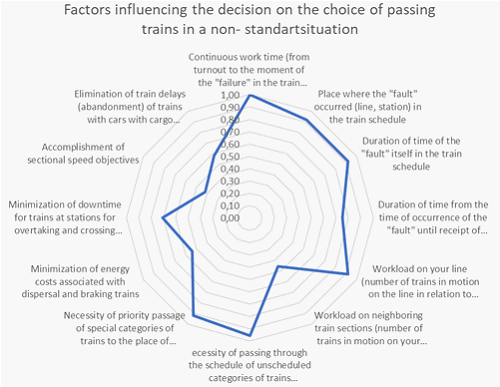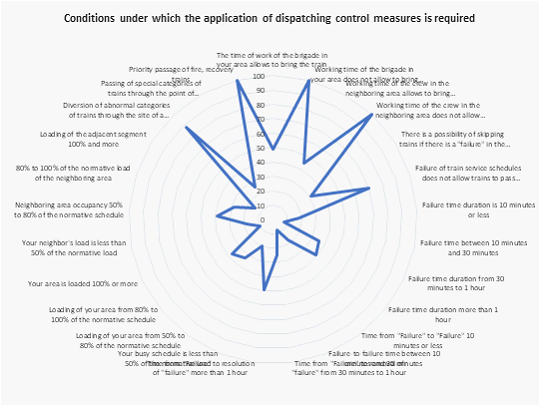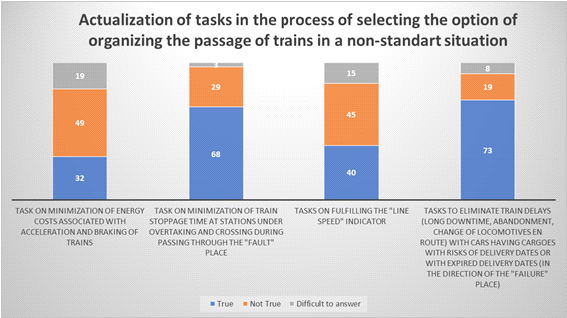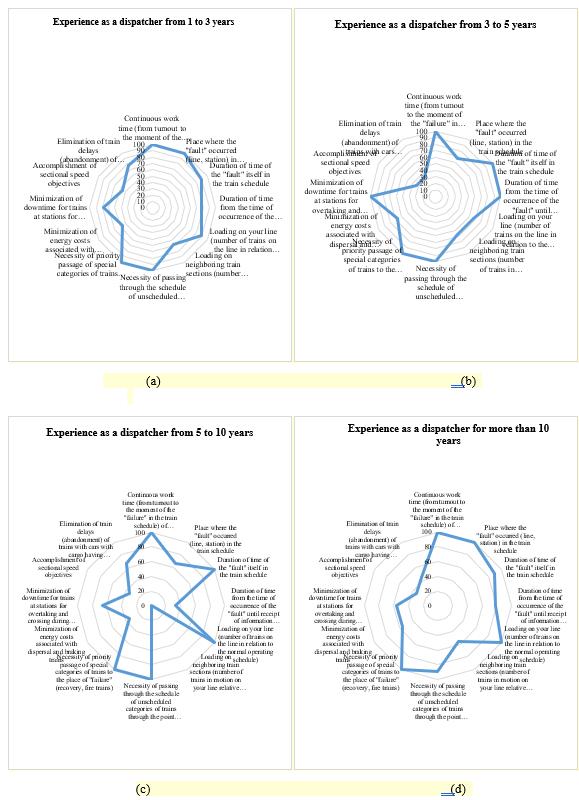Abstract
The paper analyzes the research aimed at creating new and improving existing decision support systems (hereinafter DSS), as well as the current DSS used by decision makers (hereinafter DM) to select the best options for passing trains in non-standard situations. Their weaknesses and strengths have been determined. The absence of a scientifically based and practically implemented system that meets the interests of all participants of the transportation process in selecting the optimal option of passing trains in non-standard situations has been established. The purpose of further research, which is an in-depth study in the formation of a science-based decision-making model of DM when organizing the movement of trains, was determined. Based on the analysis of schedules of executed train traffic and expert evaluations, complete information necessary for decision-making by the control room staff in a non-standard situation was established. Based on the results of the questioning of train dispatchers, a ranking of information aimed at selecting optimal solutions in a non-standard situation was performed, and the impact of its parameters on the application of dispatcher control measures was evaluated. On the basis of results of research, the conclusion about absence of a uniform approach to decision-making of DM at occurrence of a non-standard situation is drawn, on the other hand, on separate directions clear communication between the information characterizing a non-standard situation, and its parameters with decisions of DM is defined. The authors have made a rating of influence of the information on DM at decision-making in a non-standard situation.
Keywords: Complete Information, consolidated train Schedule, decision support system, decision maker, non-standard situation
Introduction
Increased competition in the market of transport services with the simultaneous increase in customer requirements for the quality of transport and logistics services leads to the need, including the development of process management quality of transport services for cargo owners and passengers (Lukinskiy et al., 2016).
As part of the implementation of this task, JSC "Russian Railways" holding a major role is given to the development of an automated system of transportation complex based on the use of the latest scientific developments in the field of dynamic management of transportation processes with the use of artificial intelligence and appropriate classes of automated solutions, but without ensuring the development of the regulatory framework and the construction of mathematical models of processes its achievement is impossible (Kobzev, 2018), therefore, science is required to make recommendations for the optimal (correct) management of such processes.
Problem Statement
Analysis of scientific works of the late XX - early XXI centuries, aimed at research and development of decision support systems (DSS) in the railway transport
The works of Yafei Hou et al. (2020), Tolmachev (2004), Odudenko (2010, 2012), and others are devoted to the study of decision support systems (DSS) and the development of proposals aimed at solving the problem of train traffic organization to increase the capacity of tracks and areas with minimum recovery time during repair and construction work, as well as in non-standard situations. At the same time, the methods themselves for evaluating the train schedule through the restraining track in order to select the optimal option for application at the workplace of the decision maker (DM) are difficult to apply due to the laboriousness and complexity of the calculations.
That is why at present it is correct to say that the available experience of research of the most optimal variants of train passing is applicable first of all for the planned development of variant schedules of train traffic during the organization of train passing during repair and construction works, long lasting faults on the infrastructure of JSC "Russian Railways", requiring closure of one or more railway tracks of sections or stations, so for initially normal conditions for the DM.
Analysis of current research aimed at research and development of decision support systems (DSS) in the railway transport
The analysis of modern research (Abid & Khan, 2015; Ahmed & Dey, 2020; Gorbachev & Novikov, 2021; Makarov & Gorbachev, 2021; Monechi, et al., 2018) devoted to this issue indicates that the vector of a large number of studies and developments of different levels is aimed at creating new and improving existing decision support systems (DSS), including those based on artificial intelligence technologies, allowing future process owners to find optimal solutions for the choice of train movement options, taking into account the multi-criteria tasks.
Thus, in addition to assisting the train dispatcher with the use of (DSS) in terms of predicting the process of train traffic, detecting conflict situations, detailing them and offering several options for returning to the planned schedule, it is proposed to train the LTRS itself, upon completion of which a variant train schedule is issued (Gorbachev & Novikov, 2021). This project is based on a software simulation block of train traffic, which is capable not only of constructing a real forecast schedule, but also of selecting and validating acceptable solutions to conflict situations.
Research (Makarov & Gorbachev, 2021) is aimed at finding optimal solutions for the owners of the process of organizing train traffic several steps ahead on the basis of game theory technology using algorithms based on machine learning artificial intelligence.
Common to most of the above studies is that further comparison and evaluation of the obtained results of decision-making, which are schedules of executed traffic, is based on the analysis of one or more criteria, such as the number of trains missed on the considered section or the time during which the "recovery" of the train schedule after its violation or the minimum time of delay of trains of unscheduled categories, etc.
Analysis of the current regulatory documentation and regulations, training programs for DM, ensuring the operation of the DSS on the railway transport
The analysis of the current regulatory documentation and regulations studied at all stages of the theoretical and practical parts of the standard individual plans for the training of train dispatchers, training plans within the training programs (Effektivnaya rabota.., 2016) shows a clear focus of training programs on traffic safety, operational planning of train and local work and labor protection, without affecting the decision-making justification when choosing the optimal options for train passing. Therefore, at the present time it can be argued that the decision-making model of DM in dispatcher regulation is currently not sufficiently studied and formed, and as a consequence, the established in practice DSS often does not meet the objectives of the owners of the process of MPL or contributes to a situation in which the result satisfies the interests of one of the DM, but does not meet the requirements of a wider range of DM in the polygon model of train traffic control. In addition, the existing DSS is characterized by the fact that decision-making is based on the knowledge gained during on-the-job training from a mentor, as well as one's own experience, often gained through trial and error. The characteristic features of the existing DSS are the following: identification of not the entire list of factors (risks) that affect decision-making, including due to lack of time; subjectivity of evaluation of the totality of all factors present by the DM; conflict of interests of a particular DM with the interests of a wider range of DM, etc.
Research Questions
One of the main visually represented systems, reflecting the management process of the transportation process is a consolidated train schedule (hereinafter - CTS), which regulates the work of all departments of the railway transport of the organization of train traffic (Elbert et al., 2019).
CTS indicators, which are natural values, are local criteria of effectiveness selected from a large number of options, the only option for the current organization of transportation. At the same time the developers of CTS, when defining local criteria of effectiveness, must strive to fulfill the global criterion of effective activity of all divisions of JSC "Russian Railways" - profit.
Thus, the results of the quality of its planning, development and, most importantly, implementation, expressed in satisfaction of passenger and freight transportation needs, train safety, the most efficient use of throughput, carrying capacity of sections and processing capacity of stations, etc. are the litmus paper characterizing the level of process management quality of transport services for freight owners and passengers (Kobzev, 2018).
As noted in the article (Golik & Kalikina, 2021) train traffic organization (TTO) is an operation that has two states: ideal (normative train schedule) and non-ideal (executed train schedule).
The "ideal" state of the TDP operation is characterized by the fact that the parameters, the totality of which form a solution, are already applied at the stage of calculating the elements of the CTS and its development, so within their competence, the DM is limited to a set of control functions (Golik & Kalikina, 2020), so the need for a new decision taken by the DM when the "non-ideal" state of TTO operation occurs, due to changes in its parameters.
In the future, the main direction of research devoted to the formation of the dispatcher control decision-making model will be the decision-making of the DM when the "ideal" state of the operation for organizing train traffic turns into the "non-ideal" one due to the influence of emerging technical and technological violations, each of which individually and in combination with other violations we assign the name "failure", creating each time a "non-standard" situation for the DM.
This direction is interesting for several reasons, one of which is that it is the decision-making of the DM when the "non-ideal" state of the operation of the organization of train traffic can be formed under all possible conditions:
- under conditions of certainty - there is complete and exhaustive information about the state of the environment necessary to make a decision;
- under conditions of probabilistic uncertainty and risk - information on the state of the environment is incomplete, but with known probabilistic characteristics of random factors;
- in conditions of complete uncertainty - there is fragmentary, fuzzy and (or) approximate information about some characteristics of the state of the environment (Petrovsky, 2009).
Purpose of the Studу
The purpose of this work is an in-depth study in the formation of a science-based decision-making model for DM in the organization of train traffic, which will form the basis for the creation of algorithms for DSS with the participation of artificial intelligence, which, according to the authors of the article is relevant and promising direction, allowing in the future to find optimal solutions in matters of organization of train traffic, given the multi-criteria problems.
Research Methods
In the course of the study, including on the basis of analysis of executed train schedules and expert evaluations of DM, full information (characterizing the failure that occurred) obtained through various communication channels (automated system for maintaining and analyzing the schedule of executed traffic, train movement logs, inspection log of tracks, switches, interlocking devices, communications and contact network, train dispatcher and telephone communication) and used for decision-making DM in the occurrence of a non-standard situation:
- location where the failure occurred;
- time duration of the failure;
- utilization of the dispatcher section (including neighboring sections);
- the need to skip extraordinary categories of trains;
- continuous time of locomotive crews.
To rank the information aimed at substantiating the optimal decisions of the DM, a survey of 180 train dispatchers of the Eastern polygon (East Siberian, Transbaikal and Far Eastern Railways) on the question "Organization of train passing in a non-standard situation" was conducted.
In the course of the questionnaire, all participants were asked:
- select factors that influence their decision on the choice of the option of organizing the passage of trains in a non-standard situation (when there is a "failure" in the train schedule);
- indicate the conditions under which (in their opinion) dispatcher control measures (overtaking (crossing), fixing, stopping to change the locomotive crew en route, removing the departure line from the technical stations in the direction of the "failure" place, etc.) are required to organize train passing in a non-standard situation (in "failure" of the train schedule);
- indicate the degree of importance of the tasks (proposed in the questionnaire) before them as DM when choosing the option of organizing the passage of trains in a non-standard situation.
Figure 1 shows a diagram showing the variants of answers to the question about the factors affecting the decision making on the choice of options for organizing the passage of trains in a non-standard situation (in the "failure" in the schedule of trains)
Figure 2 shows a diagram showing the variants of answers to the question about the conditions under which, in the opinion of the respondents, dispatcher control measures (overtaking (crossing), securing, stopping to change the locomotive crew route, removing the departure line from the technical stations in the direction of the "failure", etc.) to organize train passing in a non-standard situation (at "failure" in the train schedule).
Figure 3 shows a diagram showing the variants of responses, characterizing the opinion of the participants of the survey of the relevance of tasks, which should be guided by the DM in making decisions on options for passing trains in a non-standard situation (in the "failure" in the train schedule).
Figure 4 shows the diagram showing the variants of answers, characterizing the opinion of the survey participants regarding the factors affecting the decision-making on the choice of options for the organization of train passing in a non-standard situation (at "failure" in the train schedule), depending on the length of service of the survey participants.




Findings
The analysis of the questionnaire shows that on the one hand, at the time of the study there is no unified approach to the justification of decisions taken by the DM when the "non-ideal" state of the TTO operation (non-standard situation): each participant of the survey has "his" understanding of what is the basis for decision-making, what goals and objectives are set when making decisions and how they must be implemented, on the other hand, it should be noted that the results of the study.
On the basis of the analysis of answers of participants of a questionnaire the rating (in descending order from strong to weak) of influence of the information on DM at decision-making in a non-standard situation is made on the basis of quantity of given voices from total quantity of voices of participants of a questionnaire, thus at formation of the general rating the rating of answers is most influential under figure 1, as in the given block of questions opinions of participants concerning influence of the general characteristics and problems on DM are expressed. The least influential is determined by the rating according to Figure 2, as the participants' assessment of the influence of the DM is provided within the framework of the general characteristics and tasks affecting the DM.
1. Continuous operating time (from turnout to the time of the failure in the train schedule) of locomotive crews in trains in motion on the train section (neighboring train sections); the need for priority passage of unscheduled categories of trains to the place of failure (recovery, fire).
2. The need for priority passage of unscheduled categories of trains through the point of "failure" (passenger, commuter, special trains).
The place where the failure occurred (line, station) in the train schedule, the duration of the time of the "failure" in the train schedule, the loading of the train section (the number of trains in motion in the section in relation to the standard schedule).
4. Duration of time from the time of occurrence of the failure until receipt of information about the time of elimination of the failure; minimization of downtime of trains at stations under overtaking and crossing while passing through the place of failure.
5. Exclusion of delays (abandonment) of trains with cars having cargo with risks of delivery time or with expired delivery time.
6. Loading of neighboring train sections (the number of trains in motion on the section in relation to the standard schedule).
7. Minimization of energy costs associated with the acceleration and braking of trains; fulfillment of the task to meet the section speed.
Conclusion
In conclusion, it should be noted that the results of further work on the formation and implementation of the decision-making model of dispatcher regulation, in addition to the development of algorithms for SPDS using artificial intelligence will allow to build with high accuracy forecast train schedules with an assessment of quantitative and qualitative characteristics of options for organizing train traffic.
References
Abid, M. M., & Khan, M. B. (2015). Sensitivity analysis of train schedule of a railway track network using an optimization modeling technique. European Transport Research Review, 7(1), DOI:
Ahmed, Sh., & Dey, K. (2020). Resilience modeling concepts in transportation systems: a comprehensive review based on mode, and modeling techniques. Journal of Infrastructure Preservation and Resilience, 1(1). DOI:
Effektivnaya rabota poezdnogo dispetchera v sovremennih usloviyah. [Effective work of train dispatcher in modern conditions. Training program.] (2016). Moscow.
Elbert, R. Friedrich, Ch., Boltze, M., & Pfohl, H.-Ch. (2019). Urban Freight Transportation Systems. Imprint: Elsevier. DOI: 10.1016/C2018-0-01271-2
Golik, A. L., & Kalikina, T. N., (2020) Problemi prinyatiya resheniy poezdnim dispetcherom pri organizacii propuska poezdov posle pererivov v dvizenii [Problems of decision-making by train dispatcher in the organization of train passing after traffic interruptions]. Asia Pacific Transport, (2), 30-34.
Golik, A. L., & Kalikina, T. N., (2021) Ustenovlenie polnoy informaciyi i ocenka eye parametrov dlya prinyatiya resheniy dezurno-dispetcherskim apparatom pri organizaciyi dvizeniya poezdov v nestandartnoy situaciyi [Establishing complete information and estimating its parameters for decision making by the duty dispatcher in organizing train traffic in a non-standard situation]. Asia Pacific Transport, 3(24), 30-34.
Gorbachev, R. A., & Novikov, A. N. (2021) Virtualnoe modelirovanie i dispetcherskoe upravlenie [Virtual modeling and dispatcher control]. Railway Transport, (5), 22-26.
Kobzev, S. A. (2018). Strategia nauchno-tehnicheskogo razvitia holdinga “RZD” na period do 2025 goda I na perspektivu do 2030 goda (Belaya kniga) [Strategy of scientific and technical development of the Russian Railways holding company for the period up to 2025 and for the perspective up to 2030 (White Book)], JSC "Russian Railways".
Lukinskiy, V. S., Panova, Y., & Soletskiy, R. (2016). Simulation modelling of supply chain with allowance of reliability. Russian Journal of Logistics and Transport Management, 3(2), 49-60.
Makarov, I. Kh., & Gorbachev, R. A. (2021). Intellektualnaya sistema operativnoy korrektirovki grafika dvizeniya poezdov [Intelligent system of operative correction of train schedule]. Railway Transport, (5), 20-24.
Monechi, B., Gravin P., Di Clemente R., & Servedio V. D. P. (2018). Complex delay dynamics on railway networks from universal laws to realistic modelling. EPJ Data Science, 7. DOI:
Odudenko, T. A. (2010). Klassifikaciya i ocenka faktorov vliyauschih na prodolzitelnost pererivov v dvizenii [Classification and evaluation of factors affecting the duration of traffic interruptions]. FESTUPS, (5), 119-123.
Odudenko, T. A. (2012). Vibor sposoba organizacii propuska poezdov vo vremya i posle “okna” v zavisimosti ot parametrov gafika dvizeniya poezdov [Selection of a way to organize the passage of trains during and after the "window" depending on the parameters of the schedule of trains]. FESTUPS, (5), 75-79.
Petrovsky, A. B. (2009). Teoriya prinyatiya resheniy [Theory of decision making]. Academia.
Tolmachev, V. N. (2004) Operativnoe upravlenie propuskom poezdov na dvuhputnih uchastkah v periodi provedenia remontno-putevih rabot [Operative management of train passing on double-track sections during repair and track works]. RGOTUPS.
Hou, Y., Wen, C., Huang, P., Fu, L., & Jiang, C. (2020). Delay recovery model for high-speed trains with compressed train dwell time and running time. Railway Engineering Science, 28(4), 424-434. DOI:
Copyright information

This work is licensed under a Creative Commons Attribution-NonCommercial-NoDerivatives 4.0 International License.
About this article
Publication Date
03 June 2022
Article Doi
eBook ISBN
978-1-80296-125-6
Publisher
European Publisher
Volume
126
Print ISBN (optional)
-
Edition Number
1st Edition
Pages
1-1145
Subjects
Social sciences, education and psychology, technology and education, economics and law, interdisciplinary sciences
Cite this article as:
Golik, A. L., & Kalikina, T. N. (2022). Decision-Making Model's Formation As The Intelligent Train Traffic Control System's Basis. In N. G. Bogachenko (Ed.), AmurCon 2021: International Scientific Conference, vol 126. European Proceedings of Social and Behavioural Sciences (pp. 331-340). European Publisher. https://doi.org/10.15405/epsbs.2022.06.38

